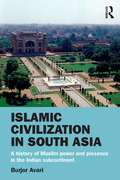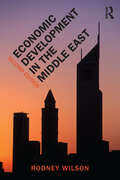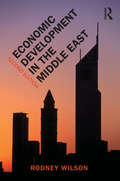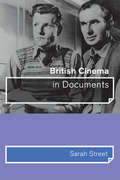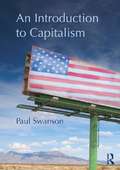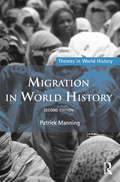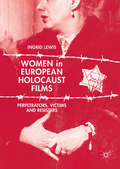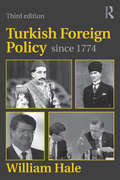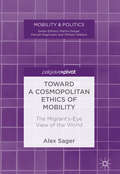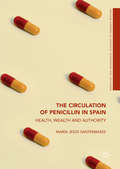- Table View
- List View
Islamic Civilization in South Asia: A History of Muslim Power and Presence in the Indian Subcontinent
by Burjor AvariMuslims have been present in South Asia for 14 centuries. Nearly 40% of the people of this vast land mass follow the religion of Islam, and Muslim contribution to the cultural heritage of the sub-continent has been extensive. This textbook provides both undergraduate and postgraduate students, as well as the general reader, with a comprehensive account of the history of Islam in India, encompassing political, socio-economic, cultural and intellectual aspects. Using a chronological framework, the book discusses the main events in each period between c. 600 CE and the present day, along with the key social and cultural themes. It discusses a range of topics, including: How power was secured, and how was it exercised The crisis of confidence caused by the arrival of the West in the sub-continent How the Indo-Islamic synthesis in various facets of life and culture came about Excerpts at the end of each chapter allow for further discussion, and detailed maps alongside the text help visualise the changes through each time period. Introducing the reader to the issues concerning the Islamic past of South Asia, the book is a useful text for students and scholars of South Asian History and Religious Studies.
Islamic Civilization in South Asia: A History of Muslim Power and Presence in the Indian Subcontinent
by Burjor AvariMuslims have been present in South Asia for 14 centuries. Nearly 40% of the people of this vast land mass follow the religion of Islam, and Muslim contribution to the cultural heritage of the sub-continent has been extensive. This textbook provides both undergraduate and postgraduate students, as well as the general reader, with a comprehensive account of the history of Islam in India, encompassing political, socio-economic, cultural and intellectual aspects. Using a chronological framework, the book discusses the main events in each period between c. 600 CE and the present day, along with the key social and cultural themes. It discusses a range of topics, including: How power was secured, and how was it exercised The crisis of confidence caused by the arrival of the West in the sub-continent How the Indo-Islamic synthesis in various facets of life and culture came about Excerpts at the end of each chapter allow for further discussion, and detailed maps alongside the text help visualise the changes through each time period. Introducing the reader to the issues concerning the Islamic past of South Asia, the book is a useful text for students and scholars of South Asian History and Religious Studies.
Economic Development in the Middle East, 2nd edition
by Rodney WilsonBy examining economic development in the Middle East in the aftermath of the Arab Spring, this textbook introduces undergraduate and postgraduate students to the most pressing and topical economic issues in the contemporary Middle East. With comprehensive coverage of the entire region, the author examines the economic prospects for the Gulf and charts the growth of economic power in the region. Organised thematically, a full range of topics are discussed, including: the role of banks and capital markets in the region’s development the impact of demographic changes, such as the dramatic decline in birth rates and the implications for future employment the development of economic advances in oil and gas production the effects of the region’s economic development on international and inter-regional trade. Through discussing the region’s problems of the past as well as the present and future challenges, this book provides students with a compact and manageable review of the state of economic development in the Middle East.
Economic Development in the Middle East, 2nd edition
by Rodney WilsonBy examining economic development in the Middle East in the aftermath of the Arab Spring, this textbook introduces undergraduate and postgraduate students to the most pressing and topical economic issues in the contemporary Middle East. With comprehensive coverage of the entire region, the author examines the economic prospects for the Gulf and charts the growth of economic power in the region. Organised thematically, a full range of topics are discussed, including: the role of banks and capital markets in the region’s development the impact of demographic changes, such as the dramatic decline in birth rates and the implications for future employment the development of economic advances in oil and gas production the effects of the region’s economic development on international and inter-regional trade. Through discussing the region’s problems of the past as well as the present and future challenges, this book provides students with a compact and manageable review of the state of economic development in the Middle East.
British Cinema in Documents
by Sarah StreetBritish Cinema in Documents presents an introduction to the key concerns and debates in British cinema through documents, ranging from official papers to fan magazines. Sarah Street shows how such documentary material can enrich our understanding of cinema's place in national culture and shed new light on defining moments in British cinema history.Street draws together a wide range of material, discussing oral histories, film posters and stills and star memorabilia alongside audience surveys, censorship reports, fan magazines and web sites, providing a context for each extract she discusses. She uses a series of case studies, including film censorship during the Second World War, the fan cultures surrounding stars from Margaret Lockwood to Ewan McGregor, and surveys of the British cinema audience to illustrate how archival research can provide a new understanding of the relationship between a film and other kinds of texts, and between films, their audiences, and the state.
A History of Social Justice and Political Power in the Middle East: The Circle of Justice From Mesopotamia to Globalization
by Linda T. DarlingFrom ancient Mesopotamia into the 20th century, "the Circle of Justice" as a concept has pervaded Middle Eastern political thought and underpinned the exercise of power in the Middle East. The Circle of Justice depicts graphically how a government’s justice toward the population generates political power, military strength, prosperity, and good administration. This book traces this set of relationships from its earliest appearance in the political writings of the Sumerians through four millennia of Middle Eastern culture. It explores how people conceptualized and acted upon this powerful insight, how they portrayed it in symbol, painting, and story, and how they transmitted it from one regime to the next. Moving towards the modern day, the author shows how, although the Circle of Justice was largely dropped from political discourse, it did not disappear from people’s political culture and expectations of government. The book demonstrates the Circle’s relevance to the Iranian Revolution and the rise of Islamist movements all over the Middle East, and suggests how the concept remains relevant in an age of capitalism. A "must read" for students, policymakers, and ordinary citizens, this book will be an important contribution to the areas of political history, political theory, Middle East studies and Orientalism.
A History of Social Justice and Political Power in the Middle East: The Circle of Justice From Mesopotamia to Globalization
by Linda T. DarlingFrom ancient Mesopotamia into the 20th century, "the Circle of Justice" as a concept has pervaded Middle Eastern political thought and underpinned the exercise of power in the Middle East. The Circle of Justice depicts graphically how a government’s justice toward the population generates political power, military strength, prosperity, and good administration. This book traces this set of relationships from its earliest appearance in the political writings of the Sumerians through four millennia of Middle Eastern culture. It explores how people conceptualized and acted upon this powerful insight, how they portrayed it in symbol, painting, and story, and how they transmitted it from one regime to the next. Moving towards the modern day, the author shows how, although the Circle of Justice was largely dropped from political discourse, it did not disappear from people’s political culture and expectations of government. The book demonstrates the Circle’s relevance to the Iranian Revolution and the rise of Islamist movements all over the Middle East, and suggests how the concept remains relevant in an age of capitalism. A "must read" for students, policymakers, and ordinary citizens, this book will be an important contribution to the areas of political history, political theory, Middle East studies and Orientalism.
The Historians of Ancient Rome: An Anthology of the Major Writings
by Ronald MellorThe Historians of Ancient Rome is the most comprehensive collection of ancient sources for Roman history available in a single English volume. After a general introduction on Roman historical writing, extensive passages from more than a dozen Greek and Roman historians and biographers trace the history of Rome over more than a thousand years: from the city’s foundation by Romulus in 753 B.C.E. (Livy) to Constantine’s edict of toleration for Christianity (313 C.E.) Selections include many of the high points of Rome’s climb to world domination: the defeat of Hannibal; the conquest of Greece and the eastern Mediterranean; the defeat of the Catilinarian conspirators; Caesar’s conquest of Gaul; Antony and Cleopatra; the establishment of the Empire by Caesar Augustus; and the "Roman Peace" under Hadrian and long excepts from Tacitus record the horrors of the reigns of Tiberius and Nero. The book is intended both for undergraduate courses in Roman history and for the general reader interested in approaching the Romans through the original historical sources. Hence, excerpts of Polybius, Livy, and Tacitus are extensive enough to be read with pleasure as an exciting narrative. Now in its third edition, changes to this thoroughly revised volume include a new timeline, translations of several key inscriptions such as the Twelve Tables, and additional readings. This is a book which no student of Roman history should be without.
The Historians of Ancient Rome: An Anthology of the Major Writings
by Ronald MellorThe Historians of Ancient Rome is the most comprehensive collection of ancient sources for Roman history available in a single English volume. After a general introduction on Roman historical writing, extensive passages from more than a dozen Greek and Roman historians and biographers trace the history of Rome over more than a thousand years: from the city’s foundation by Romulus in 753 B.C.E. (Livy) to Constantine’s edict of toleration for Christianity (313 C.E.) Selections include many of the high points of Rome’s climb to world domination: the defeat of Hannibal; the conquest of Greece and the eastern Mediterranean; the defeat of the Catilinarian conspirators; Caesar’s conquest of Gaul; Antony and Cleopatra; the establishment of the Empire by Caesar Augustus; and the "Roman Peace" under Hadrian and long excepts from Tacitus record the horrors of the reigns of Tiberius and Nero. The book is intended both for undergraduate courses in Roman history and for the general reader interested in approaching the Romans through the original historical sources. Hence, excerpts of Polybius, Livy, and Tacitus are extensive enough to be read with pleasure as an exciting narrative. Now in its third edition, changes to this thoroughly revised volume include a new timeline, translations of several key inscriptions such as the Twelve Tables, and additional readings. This is a book which no student of Roman history should be without.
The English Civil War and Revolution: A Sourcebook
by Keith LindleyThe origins, nature and consequence of the English Civil War are subjects of continuing historical controversy. The English Civil War and Revolution is a wide ranging, accessible sourcebook covering the principal aspects of the mid-seventeenth century crisis. It presents a comprehensive guide to the historiographical debates involved. Drawing on a variety of source material such as official records, private correspondence, diaries, minutes of debates and petitions, this text provides: * contextual introductions to documents * a comprehensive glossary of seventeenth century terms * a chronology of events for reference * illustrations, including contemporary woodcuts. While familiarising students with some of the main sources drawn upon by historians working in the field, The English Civil War and Revolution contains many extracts from unpublished, manuscript sources. By taking sources from all levels of society and grouping them thematically, this book offers a number of viewpoints on the civil war and revolution, thus aiding understanding of this complex period.
The English Civil War and Revolution: A Sourcebook
by Keith LindleyThe origins, nature and consequence of the English Civil War are subjects of continuing historical controversy. The English Civil War and Revolution is a wide ranging, accessible sourcebook covering the principal aspects of the mid-seventeenth century crisis. It presents a comprehensive guide to the historiographical debates involved. Drawing on a variety of source material such as official records, private correspondence, diaries, minutes of debates and petitions, this text provides: * contextual introductions to documents * a comprehensive glossary of seventeenth century terms * a chronology of events for reference * illustrations, including contemporary woodcuts. While familiarising students with some of the main sources drawn upon by historians working in the field, The English Civil War and Revolution contains many extracts from unpublished, manuscript sources. By taking sources from all levels of society and grouping them thematically, this book offers a number of viewpoints on the civil war and revolution, thus aiding understanding of this complex period.
An Introduction to Capitalism
by Paul SwansonEmbedded in an historical account of the development of U.S. capitalism up to the present day, this book gives the reader a thorough description of the major aspects of the U.S. economy, as well as a theoretical understanding of the overall economy. A particular focus of this book is how free markets work in capitalism and the interrelationship between markets and the government. Of particular interest in the current economic situation is the question of what can the government do to get the economy going again. Underlying the standard economics text today is the fundamental belief that leaving markets as free as possible will lead to the ideal economy. Directly opposing this approach, this book takes a critical stance toward free markets. Rather than viewing markets as the ideal solution to almost all economic problems, this book argues that markets are not always the answer. On the contrary, they are often the problem, and must be corrected by government action. Related to this critical stance, and in a further departure from current economics texts, this book takes an explicitly Keynesian approach to the macro-economy. Rejecting the free market approach which dominates both micro- and macro-economics today, this book offers a fresh perspective on economics and the economy today.
An Introduction to Capitalism
by Paul SwansonEmbedded in an historical account of the development of U.S. capitalism up to the present day, this book gives the reader a thorough description of the major aspects of the U.S. economy, as well as a theoretical understanding of the overall economy. A particular focus of this book is how free markets work in capitalism and the interrelationship between markets and the government. Of particular interest in the current economic situation is the question of what can the government do to get the economy going again. Underlying the standard economics text today is the fundamental belief that leaving markets as free as possible will lead to the ideal economy. Directly opposing this approach, this book takes a critical stance toward free markets. Rather than viewing markets as the ideal solution to almost all economic problems, this book argues that markets are not always the answer. On the contrary, they are often the problem, and must be corrected by government action. Related to this critical stance, and in a further departure from current economics texts, this book takes an explicitly Keynesian approach to the macro-economy. Rejecting the free market approach which dominates both micro- and macro-economics today, this book offers a fresh perspective on economics and the economy today.
Migration in World History
by Patrick ManningThis fully revised and updated second edition of Migration in World History traces the connections among regions brought about by the movement of people, diseases, crops, technology and ideas. Drawing on examples from a wide range of geographical regions and thematic areas, noted world historian Patrick Manning guides the reader through: the earliest human migrations, including the earliest hominids, their development and spread, and the controversy surrounding the rise of homo sapiens the rise and spread of major language groups (illustrated with original maps) an examination of civilizations, farmers and pastoralists from 3000 BCE to 500 CE trade patterns including the early Silk Road and maritime trade in the Mediterranean and Indian Ocean the effect of migration on empire and industry between 1700 and 1900 the resurgence of migration in the later twentieth century, including movement to cities, refugees and diasporas the various leading theories and debates surrounding the subject of migration.
Migration in World History
by Patrick ManningThis fully revised and updated second edition of Migration in World History traces the connections among regions brought about by the movement of people, diseases, crops, technology and ideas. Drawing on examples from a wide range of geographical regions and thematic areas, noted world historian Patrick Manning guides the reader through: the earliest human migrations, including the earliest hominids, their development and spread, and the controversy surrounding the rise of homo sapiens the rise and spread of major language groups (illustrated with original maps) an examination of civilizations, farmers and pastoralists from 3000 BCE to 500 CE trade patterns including the early Silk Road and maritime trade in the Mediterranean and Indian Ocean the effect of migration on empire and industry between 1700 and 1900 the resurgence of migration in the later twentieth century, including movement to cities, refugees and diasporas the various leading theories and debates surrounding the subject of migration.
Women in European Holocaust Films: Perpetrators, Victims and Resisters
by Ingrid LewisThis book considers how women’s experiences have been treated in films dealing with Nazi persecution. Focusing on fiction films made in Europe between 1945 and the present, this study explores dominant discourses on and cinematic representation of women as perpetrators, victims and resisters. Ingrid Lewis contends that European Holocaust Cinema underwent a rich and complex trajectory of change with regard to the representation of women. This change both reflects and responds to key socio-cultural developments in the intervening decades as well as to new directions in cinema, historical research and politics of remembrance. The book will appeal to international scholars, students and educators within the fields of Holocaust Studies, Film Studies, European Cinema and Women’s Studies.
Women in European Holocaust Films: Perpetrators, Victims and Resisters
by Ingrid LewisThis book considers how women’s experiences have been treated in films dealing with Nazi persecution. Focusing on fiction films made in Europe between 1945 and the present, this study explores dominant discourses on and cinematic representation of women as perpetrators, victims and resisters. Ingrid Lewis contends that European Holocaust Cinema underwent a rich and complex trajectory of change with regard to the representation of women. This change both reflects and responds to key socio-cultural developments in the intervening decades as well as to new directions in cinema, historical research and politics of remembrance. The book will appeal to international scholars, students and educators within the fields of Holocaust Studies, Film Studies, European Cinema and Women’s Studies.
Turkish Foreign Policy since 1774
by William HaleThis revised and updated version of William Hale’s Turkish Foreign Policy 1774-2000 offers a comprehensive and analytical survey of Turkish foreign policy since the last quarter of the eighteenth century, when the Turks’ relations with the rest of the world entered their most critical phase. In recent years Turkey’s international role has changed and expanded dramatically, and the new edition revisits the chapters and topics covered in light of these changes. Drawing on newly available information and ideas, the author carefully alters the earlier historical narrative while preserving the clarity and accessibility of the original. Combining the long historical perspective with a detailed survey and analysis of the most recent developments, this book fills a clear gap in the literature on Turkey’s modern history. For readers with a broader interest in international history, it also offers a crucial example of how a medium sized power has acted in the international environment.
Toward a Cosmopolitan Ethics of Mobility: The Migrant's-Eye View of the World
by Alex SagerThis book proposes a cosmopolitan ethics that calls for analyzing how economic and political structures limit opportunities for different groups, distinguished by gender, race, and class. The author explores the implications of criticisms from the social sciences of Eurocentrism and of methodological nationalism for normative theories of mobility. These criticisms lend support to a cosmopolitan social science that rejects a principled distinction between international mobility and mobility within states and cities. This work has interdisciplinary appeal, integrating the social sciences, political philosophy, and political theory.
Toward a Cosmopolitan Ethics of Mobility: The Migrant's-Eye View of the World
by Alex SagerThis book proposes a cosmopolitan ethics that calls for analyzing how economic and political structures limit opportunities for different groups, distinguished by gender, race, and class. The author explores the implications of criticisms from the social sciences of Eurocentrism and of methodological nationalism for normative theories of mobility. These criticisms lend support to a cosmopolitan social science that rejects a principled distinction between international mobility and mobility within states and cities. This work has interdisciplinary appeal, integrating the social sciences, political philosophy, and political theory.
Turkish Foreign Policy since 1774
by William HaleThis revised and updated version of William Hale’s Turkish Foreign Policy 1774-2000 offers a comprehensive and analytical survey of Turkish foreign policy since the last quarter of the eighteenth century, when the Turks’ relations with the rest of the world entered their most critical phase. In recent years Turkey’s international role has changed and expanded dramatically, and the new edition revisits the chapters and topics covered in light of these changes. Drawing on newly available information and ideas, the author carefully alters the earlier historical narrative while preserving the clarity and accessibility of the original. Combining the long historical perspective with a detailed survey and analysis of the most recent developments, this book fills a clear gap in the literature on Turkey’s modern history. For readers with a broader interest in international history, it also offers a crucial example of how a medium sized power has acted in the international environment.
The Circulation of Penicillin in Spain: Health, Wealth and Authority
by María Jesús SantesmasesThis book reconstructs the early circulation of penicillin in Spain, a country exhausted by civil war (1936–1939), and oppressed by Franco’s dictatorship. Embedded in the post-war recovery, penicillin’s voyages through time and across geographies – professional, political and social – were both material and symbolic. This powerful antimicrobial captivated the imagination of the general public, medical practice, science and industry, creating high expectations among patients, who at times experienced little or no effect. Penicillin’s lack of efficacy against some microbes fueled the search for new wonder drugs and sustained a decades-long research agenda built on the post-war concept of development through scientific and technological achievements. This historical reconstruction of the social life of penicillin between the 1940s and 1980s – through the dictatorship to democratic transition – explores political, public, medical, experimental and gender issues, and the rise of antibiotic resistance.
The Circulation of Penicillin in Spain: Health, Wealth and Authority
by María Jesús SantesmasesThis book reconstructs the early circulation of penicillin in Spain, a country exhausted by civil war (1936–1939), and oppressed by Franco’s dictatorship. Embedded in the post-war recovery, penicillin’s voyages through time and across geographies – professional, political and social – were both material and symbolic. This powerful antimicrobial captivated the imagination of the general public, medical practice, science and industry, creating high expectations among patients, who at times experienced little or no effect. Penicillin’s lack of efficacy against some microbes fueled the search for new wonder drugs and sustained a decades-long research agenda built on the post-war concept of development through scientific and technological achievements. This historical reconstruction of the social life of penicillin between the 1940s and 1980s – through the dictatorship to democratic transition – explores political, public, medical, experimental and gender issues, and the rise of antibiotic resistance.
A History of the Roman World: 753 to 146 BC
by H. H. ScullardWith a new foreword by Tim Cornell ‘Can anyone be so indifferent or idle as not to care to know by what means and under what kind of polity almost the whole inhabited world was conquered and bought under the dominion of a single city of Rome?’ – Polybius, Greek Historian The city of Rome created the foundations of an empire that would come to challenge and conquer the great civilizations of Europe and the Near East. H.H. Scullard’s definitive and highly acclaimed study reveals the peculiar genius of the Roman people, their predilection for law and order and their powers of organization and administration, all of which created a confederation the like of which the Greek World had never seen. He explores the political, military, economic and social history of this incredible empire, showing how the Romans realized an ecumenical ideal and embraced Western Civilization within one political system. Celebrated for its political and military victories as well as its incredible feats of engineering, literature and art. Scullard charts the foundation of Rome, the establishment of the Republic, and its spectacular rise until the fall of Carthage. Scullard not only explores the accomplishments of the empire but vividly delves into the corruptive foreign influences which began to undermine the moral qualities of Rome, when lust for power superseded the desire for law and order. A superb overview of this charged historical epoch, A History of the Roman World takes us inside the pivotal events and struggles which have heavily influenced modern western civilizations.
A History of the Roman World: 753 to 146 BC
by H. H. ScullardWith a new foreword by Tim Cornell ‘Can anyone be so indifferent or idle as not to care to know by what means and under what kind of polity almost the whole inhabited world was conquered and bought under the dominion of a single city of Rome?’ – Polybius, Greek Historian The city of Rome created the foundations of an empire that would come to challenge and conquer the great civilizations of Europe and the Near East. H.H. Scullard’s definitive and highly acclaimed study reveals the peculiar genius of the Roman people, their predilection for law and order and their powers of organization and administration, all of which created a confederation the like of which the Greek World had never seen. He explores the political, military, economic and social history of this incredible empire, showing how the Romans realized an ecumenical ideal and embraced Western Civilization within one political system. Celebrated for its political and military victories as well as its incredible feats of engineering, literature and art. Scullard charts the foundation of Rome, the establishment of the Republic, and its spectacular rise until the fall of Carthage. Scullard not only explores the accomplishments of the empire but vividly delves into the corruptive foreign influences which began to undermine the moral qualities of Rome, when lust for power superseded the desire for law and order. A superb overview of this charged historical epoch, A History of the Roman World takes us inside the pivotal events and struggles which have heavily influenced modern western civilizations.
